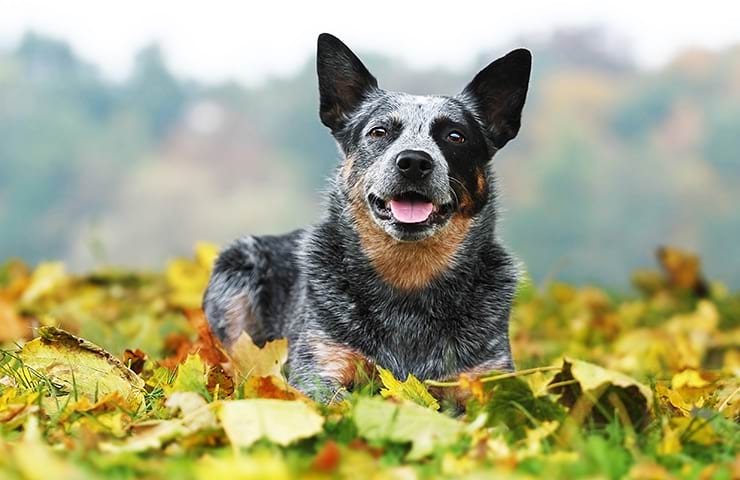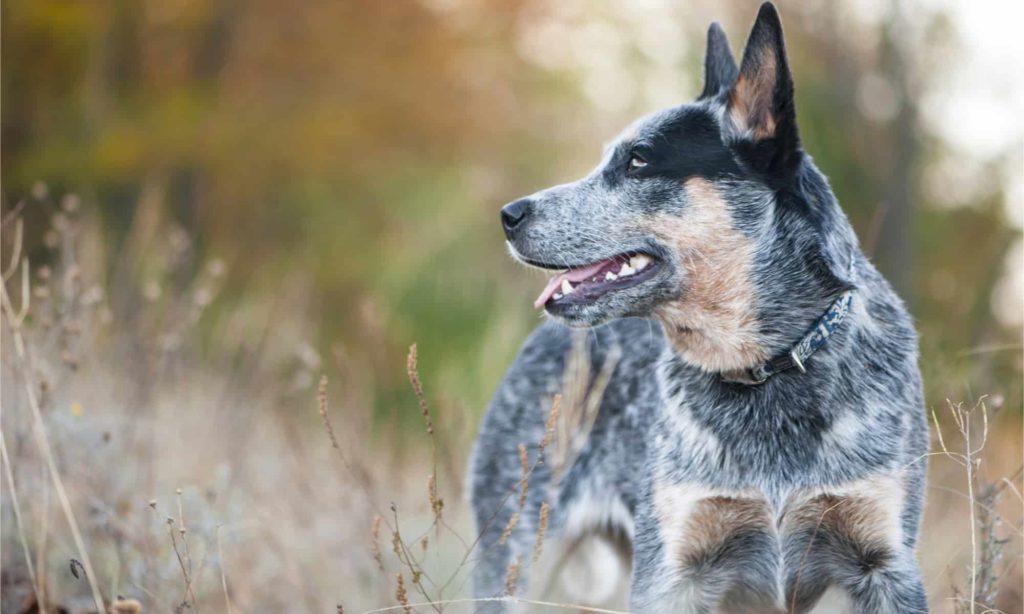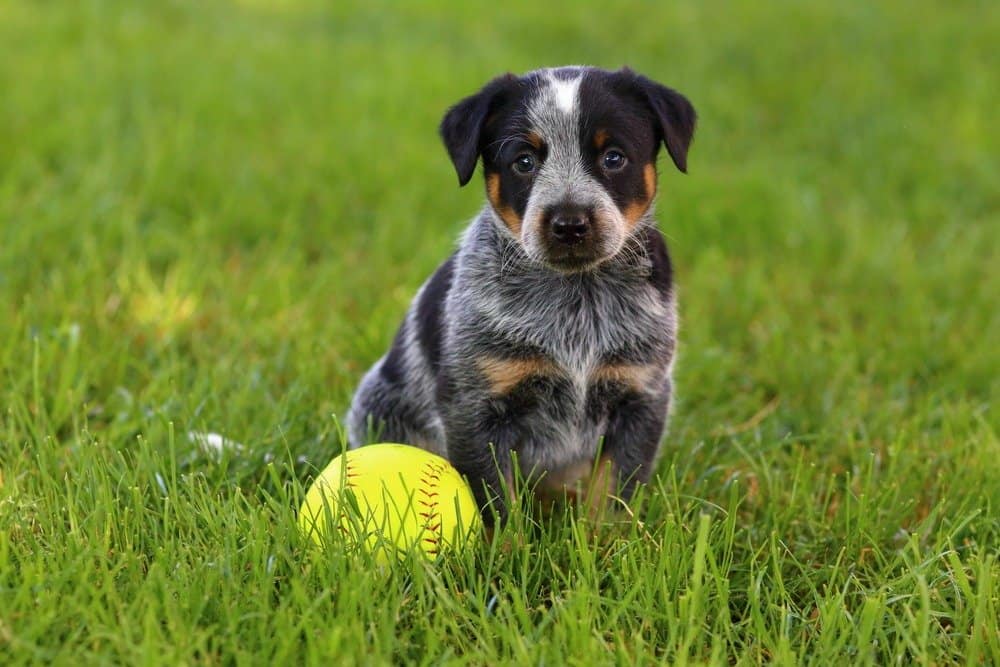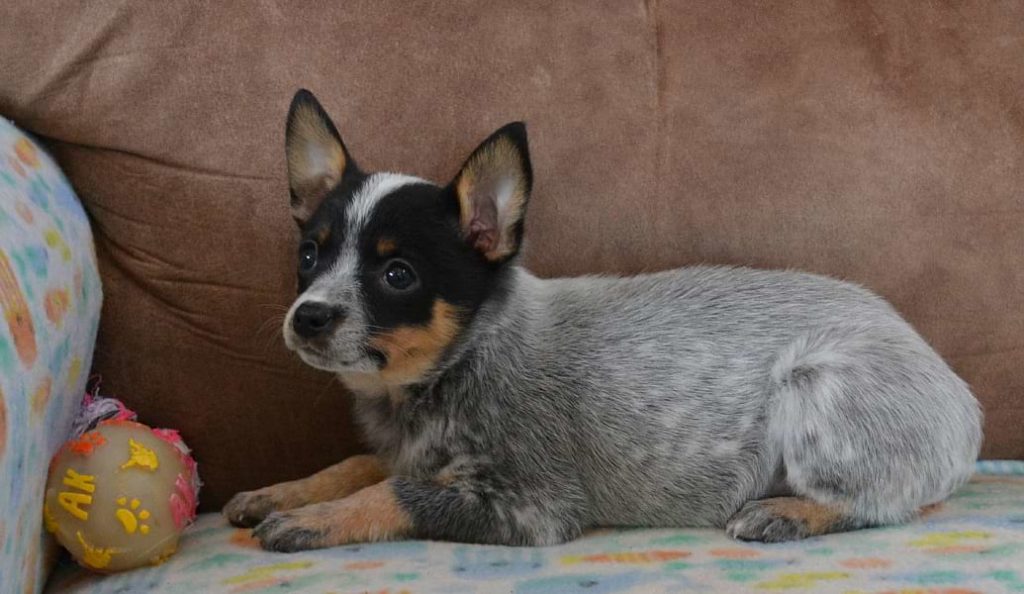The Mini Blue Heeler, also known as the Miniature Australian Cattle Dog, is a smaller version of the Blue Heeler (Australian Cattle Dog) breed.
This breed typically weighs between 15 and 35 pounds and stands between 12 and 18 inches tall at the shoulder. They are known for their muscular build, high energy levels, and strong work ethic, which makes them excellent herding and hunting dogs. Mini Blue Heelers typically have a blue or red coat and exhibit the distinctive speckled or mottled pattern of the Blue Heeler breed.
Due to their active nature, they require plenty of exercise and mental stimulation to stay happy and healthy. Mini Blue Heelers make excellent companions for families and individuals who have experience working with high-energy dogs breed and lead an active lifestyle.
A Brief Overview of Mini Blue Heeler
| Mini Blue Heeler Quick Facts | |
| Size: | 11 – 15 inches |
| Weight: | 12 – 25 pounds |
| Coat: | Short and dense |
| Hypoallergenic: | No |
| Colors: | Red or blue, with mottled or speckled markings |
| TemperamentL | Intelligent, energetic and protective |
| Family Friendly: | Yes |
| Barking: | No |
| Training: | Easy |
| Exercise: | At least 1 hour of walking per day, plus other exercise and games |
| Grooming: | Weekly brushing |
| Lifespan: | 10 – 13 years |
| Health Issues: | Hip dysplasia, deafness, retinal atrophy, and achondroplasia (dwarfism) |
| Price Range: | $500 – $1000 |
What is a Mini Blue Heeler?

A mini Blue Heeler, also known as a mini Australian Cattle Dog, is a smaller version of the standard Australian Cattle Dog, which has been bred down in size.
History of Mini Blue Heeler
The Blue Heeler, a breed that has been around for a significant amount of time, has a rich and exciting history steeped in the origins of the Australian cattle industry. While the Miniature Blue Heeler may have a shorter account than its larger counterpart, it still boasts a lineage worthy of attention and admiration.
Believe it or not, the Blue Heeler is a mixed breed, resulting from the combination of native Dingoes with herding dogs such as Collies. The Blue Heeler’s moniker stems from its bluer coat version, although they are also known by other names such as Queensland Heelers or Australian Heelers.
George Elliot developed the Australian Cattle Dog (Blue Heeler) in 1840. The breed quickly became a favorite among Australian cattlemen and ranchers due to its tireless work ethic and remarkable strength. As a result of their impressive abilities, the Blue Heeler was immediately recognized as a valuable asset for cattle herding.
Interestingly, this dog breed played an essential role in developing Australia’s beef industry, a vital component of the country’s economy. These dogs were initially imported from Britain and were of an old breed known as Smithfield. However, Australians bred them to suit the unique demands of their environment.
Today, the Australian Cattle Dog we know and love was developed after being bred with various herding dogs. The perfect mix for this breed was discovered by Jack and Harry Bagust, who produced Dalmatians with Australian Cattle Dogs—the resulting combination of working ability and faithfulness made for an exceptional breed.
Despite having been around for a long time, it wasn’t until 1980 that the AKC officially recognized the Blue Heeler. They were later designated as charter members of the AKC Herding Group in 1983, the year that the group was founded.
Mini Blue Heeler Vs. Standard Heeler

There are some notable similarities and differences when comparing the Mini Blue Heeler to its standard version. While there may be variations depending on the breeding process, generally, these two breeds share a lot in common.
Similarities
| Blue Heeler and Mini Blue Heeler | |
| Drooling: | Minimal |
| Shedding: | Minimal |
| Grooming: | Low |
| Energy level: | High |
| Intelligence: | High |
| Affection Level: | Moderate |
| Barking Tendency: | Minimal |
| Hypoallergenic: | No |
| Lifespan: | 10-15 years |
Difference
| Blue Heeler | Mini Blue Heeler | |
| Origin: | Australia | USA |
| Breed Purity: | Purebred | Purebred or mixed |
| Purpose: | Herding dog | Companion dog |
| AKC Recognition: | Yes | No |
| Size group: | Medium | Small |
| Height Range: | 17-20 inches | 11-15 inches |
| Weight Range: | 35-50 pounds | 12-25 pounds |
What Does a Mini Blue Heeler Look Like?
The Mini Blue Heeler’s appearance is reminiscent of the original Australian Cattle Dog. They have a cute, compact size and maintain the same beautiful mottled blue or red coat as their larger counterparts, along with a sturdy build and fluffy tail.
Their coat is mottled or speckled with black, tan, or white markings, usually including a mask over one or both eyes and a white patch on the forehead, aka a “Bentley star.” However, these markings are not set in stone since this breed is not officially recognized, so some dogs may not have them.
Most Healers have black noses and pads on their paws, but some can have pink ones instead! With a robust and sturdy build, short legs, and vast body, Mini Blue Heelers have a distinct triangular upright ear and a mid-length, fluffy tail. Their fur is also similar to the dingo, short and dense, which helps keep them clean and dry.
Size, height, and weight of Mini Blue Heeler
Full Grown Size
When it comes to the Mini Blue Heeler, size matters! The Mini Blue Heeler is expected to be less than 15 inches tall for breeders, while the standard Blue Heeler can range from 17 to 20 inches tall.
As adults, Mini Blue Heelers will measure between 11 and 15 inches in height and weigh between 12 and 25 pounds. That’s right. These cuties are smaller and lighter than their bigger counterparts!
Teacup Size
Some breeders may use “teacup” when referring to mini dogs, but don’t be fooled. These words sometimes mean different things. Teacup breeds are specifically bred to be as tiny as possible, with some weighing just a measly five pounds! The name itself comes from the fact that they can fit inside a teacup. However, let’s get straight: a teacup Mini Blue Heeler does not exist. The smallest Miniature Blue Heeler will be 11 inches tall and weigh around 10 pounds. That’s twice the size of a teacup breed!
It’s important to note that teacup breeds are heavily controversial, and no reputable kennel club will recognize them. They’re often produced by breeding the runts of a litter with other runts over multiple generations, ultimately creating the smallest possible dog that nature will allow. Unfortunately, breeding runts can exacerbate health issues, such as heart defects, digestive problems, seizures, and liver shunts, commonly seen in runts and miniature breeds. Plus, their size makes them a challenge to care for.
Temperament and Personality

The Mini Blue Heeler, a working dog, has a personality rooted in activity and energy. It is essential to understand that they come from a bloodline of wild and working dogs and must be kept active and engaged.
Don’t expect this breed to be lap dogs that cuddle with you all day. If you’re looking for an active and cuddly dog, consider getting a Husky instead.
As a smaller version of the Australian Cattle Dog, the Mini Blue Heeler has all the herding instincts and traits that make them energetic and hardworking. They require a home to keep them mentally and physically stimulated, making them perfect for active families who love outdoor activities and adventures. With some adult supervision, they can also play all day with older children and teenagers.
This breed is protective and bonds firmly with their families, making them central household members. While they can manage in smaller homes, giving them ample outdoor exercise and a designated indoor space for playtime is essential.
Is Mini Blue Heeler a good fit for families?
The answer is complicated and depends on several factors.
- First, consider your family’s lifestyle. Do you have young and lively kids? If so, you’ll want a patient, tolerant, and non-aggressive breed that can handle a little rough play.
- Now, regular Blue Heelers are known for their heel-biting tendency. A Mini Blue Heeler may also exhibit this behavior. But don’t worry! You can discourage this behavior with proper training and teach your Mini Blue Heeler to play nice.
- Speaking of playing, Mini Blue Heelers are incredibly energetic and love to run, jump, and play all day long. They’ll have no problem keeping up with your children’s energy levels. However, remember they’re not lap dogs and may not enjoy cuddling as much as other breeds.
Mini Blue Heelers can make great family pets, but it’s important to socialize and train them properly to ensure they fit nicely into your family dynamic.
Does Mini Blue Heeler Bark Alot?
No, they do not bark a lot. Mini Blue Heelers are generally quiet and reserved, tending to bark only when they find it necessary. This means that they are not prone to unnecessary or excessive barking, which can be a relief if you are concerned about disturbing your neighbors.
Despite their calm disposition, they are still effective as guard dogs, capable of keeping your family safe without causing a disturbance in the neighborhood. If you are looking for a loyal companion that maintains a peaceful environment, a Mini Blue Heeler could be an excellent choice.
Training

If you’re a proud owner of a Mini Blue Heeler, you probably know that training them is a breeze! These intelligent pups respond like lightning to training and enjoy the mental workout it provides. Their herding instincts make Mini Blue Heelers quick learners and follow commands quickly.
But wait, there’s more! Training your Mini Blue Heeler will also help nip annoying habits in the bud, such as biting at heels or ankles. This means you can enjoy a peaceful life with your furry friend.
Exercise Requirements
The Mini Blue Heeler requires a lot of exercise to stay happy and healthy, both physically and mentally. They are not the type of dog that will be content just sitting around the house all day. Taking them out for at least an hour a day is essential, but be careful not to walk puppies for too long as it can harm their developing joints.
But walking alone is not enough to keep these dogs happy. They crave large open spaces to run and play in, so taking them to a safe, dog-friendly field or forest is a great idea. Mini Blue Heelers can become destructive and mischievous without enough exercise, so it’s essential to provide them with plenty of opportunities to burn off that excess energy.
Play and training are also essential for keeping Mini Blue Heelers happy. They respond well to agility training, which challenges their physical abilities and intelligence. It’s a great way to bond with your dog and test your skills. So, to keep your Mini Blue Heeler happy and entertained, provide plenty of exercise, play, and training opportunities!
Grooming and Cleaning
First off, the good news: their coat is low maintenance. A quick once-a-week brushing should suffice! When bathing, try to keep it to a minimum, only about once a month or when they need it.
But there’s a catch. Twice a year, your Mini Blue Heeler will shed its undercoat, so you’ll have to be extra diligent with brushing every few days to remove all the dead hair. Be sure to use a short-bristled brush and comb it down after.
Aside from brushing, it would help if you did a few other things to keep your pup in tip-top shape. Keep their nails trimmed regularly, clean their ears, and brush their teeth every few days.
Keeping up with grooming and maintenance is a breeze with Mini Blue Heelers. Just remember to stay on top of the shedding seasons!
Are Mini Blue Heeler Hypoallergenic?
No, Mini Blue Heelers are not hypoallergenic, meaning they may not be the best choice for individuals with allergies to dogs. Although they do not shed as heavily as some other breeds and are not prone to drooling, they do shed moderately throughout the year, with increased shedding during the fall and spring seasons. Their fine fur can release dander and small particles of dead skin into the air, which might trigger allergic reactions in sensitive individuals.
If you are contemplating getting a Mini Blue Heeler and have allergies, it is important to keep this in mind and possibly spend time with the breed before making a decision to assess your tolerance.
Food and Diet
It’s best to feed them high-quality dog food to keep them healthy and energized. Whether you opt for commercially manufactured ones or prepare your own, ensure it’s highly nutritious.
No strict diet is necessary for these pups, but if they have any underlying health issues, it’s always best to check with their vet for food recommendations.
These dogs are highly active and athletic, so they need more calories to keep up with all that energy expenditure. So, expect them to eat more if they move around a lot.
Common Health Issues

Like many purebred canines, the Mini Blue Heeler can suffer from health problems caused by inbreeding. But before you cross them off your list, remember that Mini Blue Heelers can also be crossbred with other breeds, which can lead to healthier pups. Nevertheless, it’s still important to be aware of potential health issues that may arise.
1.Eyes problem
Miniature Blue Heelers are prone to vision impairments that can hinder their ability to see the world around them. A common ailment affecting their eyesight is progressive retinal atrophy (PRA). This degenerative disease gradually deteriorates the pup’s eyesight until they become completely blind, leaving them in the dark.
2.Deafness
Mini Blue Heelers might experience hearing problems like their bigger Blue Heeler cousins. These pups can either suffer from partial deafness or complete deafness. It’s a real earful, so keep an eye out for any hearing issues.
3.Pituitary dwarfism
Pituitary dwarfism is a rare medical condition that can cause many complications in both physical and cognitive development. The situation arises when there is a lack of adequate production of growth hormones in the pituitary gland. As a result, individuals with this condition may have stunted growth and underdeveloped organs.
Moreover, Pituitary dwarfism can also impact cognitive abilities. Due to insufficient brain development, individuals with this condition may have difficulties with learning, memory, and other intellectual processes.
Unfortunately, those with Pituitary dwarfism are also prone to having a shorter lifespan than those without the condition. It is essential to detect and treat the disease early to mitigate its effects and provide the best possible outcomes for those affected.
4.Hip dysplasia
Hip dysplasia, a common affliction in dogs, can also affect Mini Blue Heelers. This dysfunction can make it difficult for them to engage in physical activities like running and jumping. Over time, hip dysplasia can worsen and even lead to paralysis.
5.Patellar luxation
Patellar luxation is a condition where the Mini Blue Heeler’s kneecaps dislocate from their sockets. This can occur when the pup puts too much pressure on its joints. Although it can be painful, it’s usually a minor discomfort.
How Long Does a Mini Blue Heeler Live?
Much like its larger counterpart, the Mini Blue Heeler’s lifespan ranges from 10 to 15 years, but it’s not set in stone.
The pup’s lifespan hinges on factors like genetics, health, diet, and exercise, and some canines may live longer or shorter than expected due to unforeseen circumstances. Diseases, infections, and accidents can all impact the pup’s longevity, so it’s vital to keep them healthy and monitor their well-being closely.
How Much Is The Price of a Mini Blue Heeler?
Mini Blue Heeler puppies can fetch a price tag between $500 and $1,000, which will depend on the breeder. Interestingly enough, Miniatures cost less than their standard.
Is Mini Blue Heeler Right For Me?
When finding the perfect fur buddy, the Mini Blue Heeler is a pup that requires an active lifestyle. If you’re looking for a canine companion that’s agile, intelligent, hardworking, and full of energy, then the Mini Blue Heeler is right up your alley.
However, if you’re looking for a dog that enjoys snuggling up with you on the couch or just lounging around, then this breed may not be the best fit for you. This dog is always on the go and needs plenty of physical and mental stimulation to keep him happy and healthy.
List of dogs that are similar to Mini Blue Heeler
- Blue Heeler-Jack Russell Mix
- Blue Heeler-Rat Terrier Mix
- Blue Heeler-Chihuahua Mix
- Blue Heeler-Corgi Mix
Frequently Asked Questions
Does Mini Blue Heeler Shed A Lot?
No, they do not shed a lot compared to other breeds.
Miniature Blue Heelers, while not completely exempt from shedding, are known to shed less than many other dog breeds. They have a double coat of fur, which includes a coarse outer layer and a denser, softer undercoat. This double coat offers them protection against harsh weather conditions but also leads to a moderate amount of shedding.
Despite the shedding, it is not excessively high compared to other breeds, but it can still be substantial enough to affect individuals with allergies. It is recommended for potential owners with allergies to consider this aspect seriously before choosing this breed. To manage the shedding and make it more tolerable, especially for those with allergies, regular brushing can be a helpful routine to reduce the amount of fur dispersed around the home.
Conclusion
In conclusion, the Mini Blue Heeler is a smaller version of the Blue Heeler (Australian Cattle Dog) breed that exhibits many of the same traits and characteristics as its larger counterpart. These dogs are known for their muscular build, high energy levels, and strong work ethic, making them excellent herding and hunting dogs.
They require plenty of exercises and mental stimulation to stay happy and healthy and make great companions for families and individuals who have experience working with high-energy dogs. As with any breed, early socialization and training are essential to ensure that Mini Blue Heelers develop into well-behaved and obedient pets.
With the proper care, love, and attention, the Mini Blue Heeler can become a loyal and affectionate companion for many years.

Pingback: Blue Heeler Catahoula Mix: A Unique Blend of Breeds 2023
Pingback: Blue Heeler Jack Russell Mix: Facts You Need To Know 2023
Pingback: Blue Heeler Husky Mix: Interesting Facts You Need to know 2023
Pingback: Blue Heeler Chihuahua Mix: Revealing Hidden Wonders 2023
Pingback: Rottweiler Blue Heeler Mix: Dive into the Interesting World 2023
Pingback: Blue Heeler Rat Terrier Mix: Revealing Hidden Wonders 2023